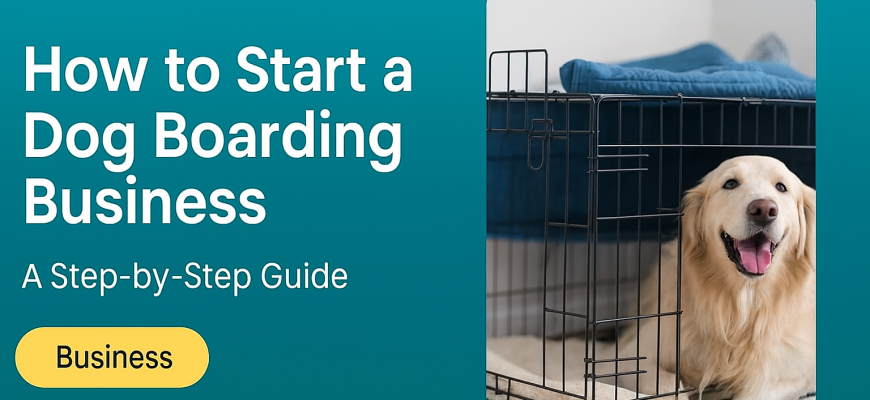Every successful business starts with a dream and a plan. If you love dogs and entrepreneurship, you’re in the right place. The pet industry is booming, and dog boarding is especially growing as pet owners spend more on quality care. Imagine helping busy families and travelers by giving their dogs a safe, loving “home away from home” – all while building your own thriving business. As a woman entrepreneur, you bring compassion, organization, and community focus to the table. This guide will empower you with practical steps – from planning and legal essentials to facilities and marketing – so you can confidently launch a dog boarding business in the U.S.
Starting strong means doing your homework. Research your local market: how many dog owners are in your area, and what services do existing kennels offer? Next, write a detailed business plan. A solid plan “describes your business, services, financial plans, [and] operations” to keep you on track. Outline your goals, describe your target customers (busy professionals, vacationers, etc.), and sketch out start-up and operating costs. This plan will serve as your roadmap and can be shared with lenders or partners. Remember, a well-crafted plan is the first step to success.
Business Planning & Legal Setup
A great dog boarding business needs a strong legal and financial foundation. Key steps include structuring your company, handling taxes, and obtaining the right permits:
-
Business Plan: Write a clear plan covering your vision, services (boarding, daycare, grooming add-ons), pricing, and marketing strategy. Include a market analysis to demonstrate demand in your area, and financial projections (startup costs, revenue forecasts).
-
Legal Structure & Tax ID: Choose a legal entity (LLC is popular for small businesses) to protect your personal assets. Register for an Employer Identification Number (EIN) with the IRS and open a business bank account. Keeping business finances separate makes taxes and record-keeping much easier.
-
Licenses & Permits: Apply for a general business license from your city or county. In many places, running a pet boarding kennel also requires a specific kennel or pet care permit. (For example, if dogs stay overnight you often need a kennel or daycare license.) Fees for these licenses typically average around $1,000 nationwide. Research your local regulations carefully, as rules can vary by county or city.
-
Insurance: Obtain liability insurance to protect against lawsuits (if a pet is injured or escapes) and property insurance to cover your facility and equipment against damage. These are essential. Without insurance, even a single accident could financially ruin your business. Always factor insurance costs into your budget.
-
Zoning and Location: Confirm that your chosen location is zoned for commercial animal care. Many residential areas prohibit kennels due to noise or space rules. Check with local zoning boards – sometimes kennels are only allowed in certain commercial or agricultural zones. If you plan to operate from your home, you may also need a home-occupation permit.
-
Health & Safety Compliance: Plan to comply with local health regulations. Most areas require proof of pet vaccinations (rabies, distemper, etc.) before boarding and regular health inspections. You’ll need sanitary waste disposal per local codes (for example, no dumping animal waste into drains). Prepare simple contracts and waivers for pet owners, plus any employee agreements.
Completing these steps up front builds confidence and legitimacy. For example, as one guide notes, you should “obtain a business license” and make sure to “check for any state licenses” needed. With your business officially registered and insured, you can move on to creating a safe, functional facility.
Operational Setup & Facilities
Now let’s design the heart of your business: the boarding facility and daily operations. Your priority is safety and comfort for the dogs and a smooth workflow for your team.
-
Facility Layout: Choose or build a space with secure fencing and a layout that prevents escapes. Invest in sturdy indoor kennels or runs—each should be large enough for a dog to stand, turn around, and lie down comfortably. Plan multiple areas: separate play yards or rooms (both indoor and outdoor) so dogs can exercise safely, plus a quiet sleeping area. Include a dedicated kennel or room for meal prep and feeding, and consider a grooming/bathing area for future growth. Good ventilation and temperature control are essential. In short, every kennel “facility” should be escape-proof and designed with animal comfort in mind.
-
Safety & Hygiene: Maintain a spotless environment. Dogs are susceptible to infections, so develop a rigorous cleaning routine. Disinfect kennels, play toys, water bowls, and surfaces daily. Use pet-safe cleaning products and wash bedding frequently. Provide tools for quick cleanups of accidents. Also set up a sanitary waste disposal system (for example, a covered bin or compost system) to handle dog waste safely. One expert reminds us: “Dogs are going to create waste, so you want to ensure you have a sanitary place to dispose of it”. By keeping everything clean, you protect the animals and give owners peace of mind.
-
Kennels & Equipment: Stock quality supplies. Provide durable crates or runs, soft bedding (blankets or raised dog beds), and bowls for food and water. Keep ample toys (chew toys, balls) to reduce stress. Make sure electrical outlets are protected and there are no loose wires. Have a first-aid kit (for pets) and fire extinguishers on site. Good ventilation, non-slip flooring, and safe surfaces (no sharp edges) are also important. You might also install cameras if owners appreciate live video updates (which can also build trust).
-
Staffing & Training: Your team will make or break the experience. Seek helpers who are truly dog lovers. Look for people with pet-care or volunteer experience, and ideally basic pet first-aid training. During hiring, emphasize kindness and responsibility. Once on board, train them thoroughly: cover everyday routines (feeding schedules, cleaning protocols) and emergency procedures (how to handle a dog fight or medical incident). One boarding guide advises training staff in “general care for dogs, first aid for the animals and humans, [and] what to do in an emergency”. Keep staff culture positive – happy, well-trained employees lead to happy pets.
-
Records & Routine: Implement an intake process. Have every pet owner fill out a form with the dog’s health info, diet, and emergency contacts. Require proof of vaccinations (most places legally mandate current rabies and other shots). Store these records (digital or paper) securely. Develop a daily schedule: set times for feeding, potty breaks, walks/play, and rest. Use checklists to track each dog’s needs. Good records (date and time of feedings, any medicine given, notes on behavior) keep communication clear and help prevent mistakes. This organization is your best friend when dozens of tails start wagging at once.
With everything in place – a safe facility, clear procedures, and trained staff – you’ll deliver top-notch care. Remember that your highest priority is the welfare of the dogs. As one trainer put it, “Any pet care provider’s top priority should always be maintaining the safety of the pets in their care”.
Marketing & Building Trust
Even the best boarding kennel needs customers, so let’s spread the word and build trust in your community. Women entrepreneurs often excel at relationship-building – use that to your advantage! Here’s how:
-
Professional Online Presence: In today’s world, pet owners research online first. Make a polished, mobile-friendly website that clearly describes your services, rates, hours, and contact info. Include plenty of friendly photos of your facility and pups at play, plus glowing client testimonials. According to industry experts, “more than 80% of your future customers will do online research by reading your Google reviews, checking your Yelp listing, and visiting your website”. Ensure your branding (logo, colors) looks professional and welcoming. A strong site signals that you’re a serious, reliable business.
-
Local SEO & Reviews: Claim and optimize your Google Business listing (so you appear on Maps) and other directory listings. Make sure your name, address, and phone number are consistent everywhere. Encourage each satisfied client to post a review on Google, Facebook, Yelp, etc.. Online reviews are critical social proof: roughly 99% of people check them before booking. In fact, about half of consumers trust online reviews as much as personal recommendations. Highlight your best reviews on your website. And always respond (even to negative ones) politely – engagement shows you care about feedback.
-
Social Media Engagement: Use Facebook and Instagram to show off your daily life. Post pictures of playful pups, staff at work, and behind-the-scenes glimpses. Share pet care tips or funny dog facts. When potential customers see lively, positive images of your kennel, they’ll feel more comfortable entrusting you with their pets. You might also host fun online contests (e.g. cutest dog photo) to engage the community. Remember: social media is informal, but keep your tone friendly and helpful.
-
Testimonials & Referrals: Humanize your marketing with real stories. Display heartfelt testimonials prominently (on your site and in marketing materials). Positive experiences from other pet owners “alleviate concerns” for hesitant clients. For example, a line like “I dropped off Max knowing he’d be spoiled with love – I got daily updates and returned to a happy, tired pup!” can resonate deeply. You can also offer a referral discount: encourage current clients to send friends and family your way in exchange for a free night or discount. Word-of-mouth is gold – one satisfied customer often leads to several new ones.
-
Community Partnerships: Leverage local connections. Reach out to nearby veterinarians, groomers, pet stores and shelters. A simple cross-promotion can do wonders: one marketing guide suggests to “partner with local veterinarians and pet stores to cross-promote each other’s services”. For instance, you could offer a small discount to clients of a pet store, and in return they hand out your brochures. You might also collaborate with dog trainers or walkers to refer clients back and forth. Finally, consider local events: host an open house or a free seminar on dog care. These activities position you as a trusted expert and get your name out there.
By building a professional image and nurturing relationships, you’ll quickly gain loyal clients. Keep the focus on care and quality – satisfied pet parents will become your best advertisers. As one review-oriented article notes, when clients share their good experiences online and with friends, your “revenue (and reputation) is on the line” in the best way possible!
Your Paw-sitive Future
Starting a dog boarding business is a big step, but with passion and preparation you can make it a success. Recall the essentials: plan your business carefully with a strong plan and budget, handle all legal and insurance requirements, and create a safe, welcoming facility for dogs. Then, showcase your commitment with smart marketing: an easy-to-find website, active social media, and plenty of happy customer stories.
Believe in yourself and your vision. The pet care industry welcomes dedicated entrepreneurs, and the demand for quality dog boarding is only growing. You have the heart to care and the drive to manage the details. Take each step confidently: by putting in the work now, you’ll soon be enjoying the rewards of a business that lets you help animals and enrich your own life. Good luck – the dogs (and your future clients!) are rooting for you.









